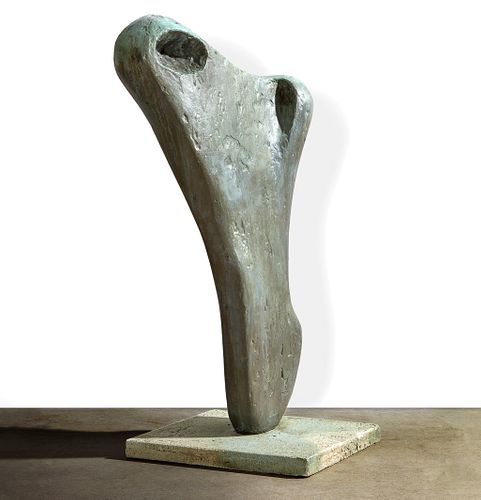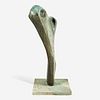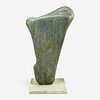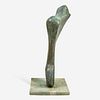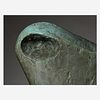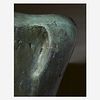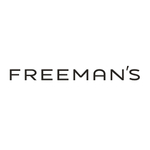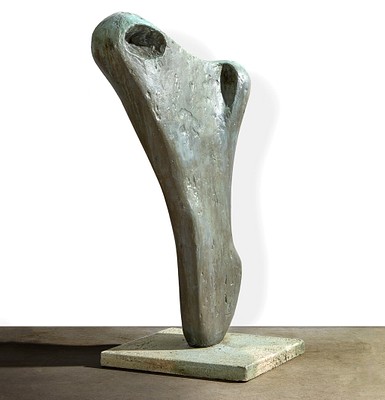Barbara Hepworth (British, 1903-1975) Torso II (Torcello)
About Seller
2400 Market St
Philadelphia, PA 19147
United States
Established in 1805, Freeman’s Auction House holds tradition close, with a progressive mind-set towards marketing and promotion, along with access to a team of top experts in the auction business. And now with offices in New England, the Southeast, and on the West Coast, it has never been easier to ...Read more
Two ways to bid:
- Leave a max absentee bid and the platform will bid on your behalf up to your maximum bid during the live auction.
- Bid live during the auction and your bids will be submitted real-time to the auctioneer.
Bid Increments
| Price | Bid Increment |
|---|---|
| $0 | $25 |
| $500 | $50 |
| $1,000 | $100 |
| $2,000 | $200 |
| $3,000 | $250 |
| $5,000 | $500 |
| $10,000 | $1,000 |
| $20,000 | $2,000 |
| $30,000 | $2,500 |
| $50,000 | $5,000 |
| $100,000 | $10,000 |
About Auction
May 11, 2021
A collection of Modern and Contemporary art including an etching from William Kentridge's Sleeper Series. Curated by David Weiss, Senior Vice President and Head of Sale for the Modern and Contemporary Art department at Freeman's. Freeman's info@freemansauction.com
- Lot Description
Barbara Hepworth (British, 1903-1975) Torso II (Torcello)
1958, stamped 3/6 bottom center, Susse Frères, Paris foundry. Bronze with cement base.
Dimensions without base:
height: 34 1/4 in. (87cm)
width: 21 in. (53.3cm)
depth: 10 in. (25.4cm)
base: 1 1/2 x 16 x 16 in. (3.8 x 40.6 x 40.6cm)Provenance
Gimpel Fils, London, United Kingdom.
Private Collection (acquired directly from the above in 1961).
Private Estate (by family descent).
Footnote:Exhibited
"Barbara Hepworth ,” Gimpel Fils, London, May 1958, cat. no.10 (another cast exhibited).
“Modern Sculpture,” Leeds City Art Gallery, United Kingdom, October 8 - November 5, 1958, cat. no. 39 (another cast exhibited).
“Moments of Vision,” Rome-New York Art Foundation, Rome, July - November 1959, p. 30 (another cast exhibited).
“Hepworth,” Galerie Chalette, New York, October - November 1959, cat. no. 23, illustrated (another cast exhibited).
“Summer Exhibition,” Penwith Society of Arts, St. Ives, United Kingdom, 1960, cat. no. 49 (another cast exhibited).
“Northern Artists,” Manchester City Art Gallery, United Kingdom, July 16 – August 7, 1960, cat. no. 26 (another cast exhibited); also traveled with Arts Council tour to Graves Art Gallery, Sheffield; Laing Art Gallery, Newcastle-upon-Tyne; Bolton Art Gallery, Bolton; Bradford City Art Gallery, Bradford; Carlisle Public Library and Art Gallery, Carlisle.
“Malerei und Plastik aus Leeds,” Stadthaus Unterer Galerie, Dortmund, Germany, May - June 1961, cat. no. 25 (another cast exhibited).
“Sculpture 1961,” National Museum of Wales, Cardiff, July 15 - September 2, 1961, cat. no. 22, illustrated (another cast exhibited); also traveled with Welsh Committee of the Arts Council tour to Glynn Vivian Art Gallery, Swansea; National Library of Wales, Aberystwyth; University College, Bangor.
“Barbara Hepworth: An Exhibition of Sculpture from 1952-1962,” Whitechapel Art Gallery, London, May - June 1962, cat. no. 30, illustrated (another cast exhibited).
“International Exhibition and Sale of Contemporary Art,” O'Hana Gallery, London, November 15 – 24, 1962, cat. no. 18 (another cast exhibited).
“Autumn Exhibition 1962,” Penwith Society of Arts, St. Ives, United Kingdom, Autumn 1962, un-numbered exhibition (another cast exhibited).
“Barbara Hepworth: Sculpture and Drawings,” John Lewis Partnership, Oxford Street, London, April 1963, cat. no. 4 (another cast exhibited).
Little Missenden Festival, United Kingdom, October 1965 (another cast exhibited).
“Collectors' Choice XIV,” Gimpel Fils, London, June 1967, cat. no. 25, illustrated (another cast exhibited).
“Barbara Hepworth,” Gimpel Fils, London, October - November 1972, cat. no. 8 (another cast exhibited).
“Barbara Hepworth: 50 Sculptures from 1935 to 1970,” Gimpel Fils, London, October 7 - November 15, 1975, cat. no. 19, illustrated (another cast exhibited).
“Barbara Hepworth,” Yorkshire Sculpture Park, West Bretton, July 19 - October 31, 1980, cat. no. 5, illustrated p. 15 (another cast exhibited).
Literature
Bowness, Alan, Barbara Hepworth, London 1961, no. 234 (another cast illustrated).
Hodin, J.P., Barbara Hepworth, London: Lund Humphries , 1961, pp. 22, 169, no. 234 (another cast illustrated).
Hammacher, A. M., et al., Barbara Hepworth, London: Thames & Hudson, 1968, rev. ed. 1987, p. 130, 138, pl. 106 (another cast illustrated).
Jenkins, David Fraser, Barbara Hepworth: A Guide to the Tate Gallery Collection at London and St. Ives, Cornwall, London: Tate, 1982, p. 17, 31 (another cast illustrated).
Tate Gallery Acquisitions 1980-2, London: Tate, 1984, pp. 115-16, (another cast illustrated).
Cork, Richard, “On Growth and Form,” Tate: The Art Magazine, (Winter 1994) no. 4, p. 38 (another cast illustrated).
Festing, Sally, Barbara Hepworth: A Life of Forms, London: Viking, 1995, p. 229.
Gale, Matthew and Chris Stephens, Barbara Hepworth: Works in the Tate Gallery Collection and the Barbara Hepworth Museum St. Ives, London: Tate, 1999, cat. no. 41, p. 169 (another cast illustrated).
Curtis, Penelope, Barbara Hepworth, London: Tate, 1998/2013, p. 52, 53 (another cast illustrated).
Note
The sculpture will be included in the upcoming revised catalogue raisonné of the artist's work as BH 234, by Dr. Sophie Bowness, Hepworth Estate, London.
Growing up on the West Riding, Yorkshire where her father was a land surveyor, Barbara Hepworth developed early on a keen awareness of the rounded forms of hill and landscape juxtaposed against sweeping coastlines, all shaped by movement of wind and sea. The rounded forms, cavities, textures, crevices and hollows that define her mature work evoke these formative visual memories.
After attending art school in the 1920s at the Leeds Art School (where Henry Moore was a fellow student) and the Royal College of Art, London, Hepworth studied in Paris and Italy, including a period studying the carving of marble from master-carver Giovanni Ardini. Hepworth was married to two artists, first to John Skeaping and later to Ben Nicholson, and spent decades living and working mainly in England and France. Throughout the 1930s and 1940s, Hepworth worked prolifically, and visited and exhibited with artists including Picasso, Braque, Calder and Gabo.
The early 1950s, however, were a period of pain and loss for Barbara Hepworth. Unforgettable memories and images of human suffering, death, and destruction were indelibly stamped upon the collective consciousness of human experience as a result of the Second World War. In addition, Hepworth's marriage to Ben Nicholson broke up, closely followed by the 1953 death of her son who was flying in the Royal Air Force. Former studio assistant, David Lewis described the artist's grief during this time as a "physical as well as an emotional cavity which....became real in the hollows and tunnels of her sculptures, a way of expressing - as a woman and a sculptor - an emotional and spiritual inwardness within outer form."Executed in 1958, Torso II (Torcello) is the second of three torso variations created in a period when Hepworth had begun working with expanded aluminum as a hollow framework for the application of plaster used to create her sculpture. This technique allowed the artist a certain fluidity and speed with which to create weighty forms with intention and specificity, something she found previously defined, and perhaps limited by the inherent nature of wood or stone. Interestingly, however, with bronze, Hepworth found she could yet manipulate the surface of the medium as she had with stone and wood. “I only learned to love bronze when I found that it was gentle and I could file it and carve it and chisel it” she stated in a letter to Ben Nicholson, from October 2, 1966. Indeed, the surface of Torso II (Torcello) bears intentional texture and crags that reveal the artist's touch and attention to the entirety of this truncated and abstracted human form. Viewed from one perspective, Torso II (Torcello) is a sold mass which bears such critical voids and curved hollows, textured and slightly mottled yet glowing with the warmth of bronze beneath the cool tones of its weathered surface. Yet, viewed from another angle, the form is slender and appears to list slightly, showing a perhaps more vulnerable perspective of human form.
The subtitles of the three Torsos offer Mediterranean associations which may have been inspired by the artist's important trip to Greece in 1954. Torcello is the name of an island north of Venice known for its Byzantine Basilica and mosaics. Torso II (Torcello) offers a vulnerable human form shaped and uniquely marked by Hepworth's hand and grounded in both land and sea. “I remember standing on Patmos and thinking - with that incredible stretch of sea and islands before me - how intensely a figure rising in the distance expressed that perfect elevation of the human spirit which in a way is conveyed by a powerful sculptured form..." [1]
Other examples from the edition reside in the collections of the Tate, The Los Angeles County Museum of Art, and the Auckland Art Gallery.
[1] J.P. Hodin, Barbara Hepworth, London: Lund Humphries , 1961, p. 10. - Shipping Info
-
No lot may be removed from Freeman’s premises until the buyer has paid in full the purchase price therefor including Buyer’s Premium or has satisfied such terms that Freeman’s, in its sole discretion, shall require. Subject to the foregoing, all Property shall be paid for and removed by the buyer at his/ her expense within ten (10) days of sale and, if not so removed, may be sold by Freeman’s, or sent by Freeman’s to a third-party storage facility, at the sole risk and charge of the buyer(s), and Freeman’s may prohibit the buyer from participating, directly or indirectly, as a bidder or buyer in any future sale or sales. In addition to other remedies available to Freeman’s by law, Freeman’s reserves the right to impose a late charge of 1.5% per month of the total purchase price on any balance remaining ten (10) days after the day of sale. If Property is not removed by the buyer within ten (10) days, a handling charge of 2% of the total purchase price per month from the tenth day after the sale until removal by the buyer shall be payable to Freeman’s by the buyer. Freeman’s will not be responsible for any loss, damage, theft, or otherwise responsible for any goods left in Freeman’s possession after ten (10) days. If the foregoing conditions or any applicable provisions of law are not complied with, in addition to other remedies available to Freeman’s and the Consignor (including without limitation the right to hold the buyer(s) liable for the bid price) Freeman’s, at its option, may either cancel the sale, retaining as liquidated damages all payments made by the buyer(s), or resell the property. In such event, the buyer(s) shall remain liable for any deficiency in the original purchase price and will also be responsible for all costs, including warehousing, the expense of the ultimate sale, and Freeman’s commission at its regular rates together with all related and incidental charges, including legal fees. Payment is a precondition to removal. Payment shall be by cash, certified check or similar bank draft, or any other method approved by Freeman’s. Checks will not be deemed to constitute payment until cleared. Any exceptions must be made upon Freeman’s written approval of credit prior to sale. In addition, a defaulting buyer will be deemed to have granted and assigned to Freeman’s, a continuing security interest of first priority in any property or money of, or owing to such buyer in Freeman’s possession, and Freeman’s may retain and apply such property or money as collateral security for the obligations due to Freeman’s. Freeman’s shall have all of the rights accorded a secured party under the Pennsylvania Uniform Commercial Code.
-
- Buyer's Premium



 EUR
EUR CAD
CAD AUD
AUD GBP
GBP MXN
MXN HKD
HKD CNY
CNY MYR
MYR SEK
SEK SGD
SGD CHF
CHF THB
THB